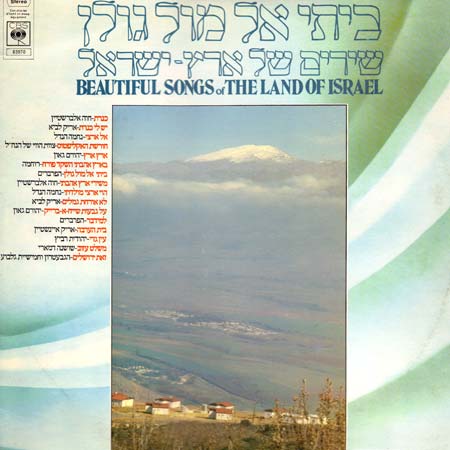The story of the Gevatron troupe begins in early 1948, when a group of singers in Kibbutz Geva performed at the dedication of a new basketball court in the kibbutz. They called themselves the “Gevatron” – a combination of the name of the kibbutz with the name of the “Cheezbatron”, a singing troupe that performed during the War for Independence. The young group started performing for communal occasions in the kibbutz, with accordion accompaniment. They were amateurs and sang mainly verses, written by members of the kibbutz, to borrowed melodies, Russian songs for the most part. In 1961 the group sang at the “Kibbutz Festival” in Tel-Aviv. There the entrepreneur Ze’ev Havatselet introduced them to the composer Nahum Hayman, who lived at that time in Kibbutz Beit-Alpha, near Geva. Hayman was then working with a small band of musicians from the district, who called themselves “The Gilboa Quintet”. He started working with the Gevatron, accompanied by the band. The troupe performed all over the country, and after a while came out with its first record, “Where is the Wind Blowing To?”, in memory of Ze’ev Havatselet who died in an accident. “Hayman took this group of amateurs and turned it into a real singing troupe,” tells us Yoel Parness, managing director of the Gevatron. With Danny Or-Stav the group put out its second record, “Songs From the Shack”.
After working together for seven years, Hayman went abroad, and the troupe started working with Dov Carmel from Kibbutz Dahlia. Three years later Haim Agmon took his place. Some of Agmon’s songs, like “Ocean of Sheaves” and “My Valley” (lyrics by Yitshak Kainan. Kainan and Agmon were both residents of the city of Beit-Shean) became conventional Israeli songs. After him followed Tsvika Caspi and the present musical director, Ilan Gilboa. During the period with Haim Agmon, the Gevatron updated the character of its performances and started working with a stage director. The first one was Benny Porat. Later Aaron Herzog and Ella Alterman took his place. Today the stage director is Danny Litai.
With its numerous performances, the troupe brought the songs of Israel to every corner of the country. The Gevatron has appeared at many official functions, and has often given voluntary shows for hospitals and for soldiers. During times of war the Gevatron troupe volunteered to sing anyplace where there were soldiers, sometimes before three or four boys in army posts on the Golan Heights, or in the most distant points in the Sinai. Naturally, some of the singers themselves were drafted in wartime to serve in the reserves.
At one of the performances during the Yom Kippur War, members of the group rejoiced to see in the soldier audience one of its members, Yoav Nachshon, who happened to be commander at that post. Of course, he joined the group on stage.
The Gevatron’s special style attained a place of honor in the hearts of the Israeli audience. It has published over twenty albums, six of which were awarded a “gold record”, which marks extensive sales. At the peak of its popularity, in the 1980’s, an audience of 120 thousand came to the performance in the Yarkon Park in Tel-Aviv. The troupe worked in co-operation with many prominent singers of Hebrew songs – Joram Gaon, Shoshana Demari, Judith Ravitz, Hanan Yovel, and others. The Gevatron frequently appeared abroad, representing Israel and bringing the unique sounds of Israeli music to Jewish communities all over the world. In 1972 it was awarded the “David’s Harp” prize, and in 1992 it received the Histadrut prize. In 2008 it received the Israel Prize for lifelong endeavor.
In spite of the high musical standard and the work load of rehearsals and performing, everything is done voluntarily. The members are not paid, and continue working at their regular jobs in the kibbutz. Even when they get home from a performance in the middle of the night, they get up at 6:30 in the morning and show up for work. In 1982 the troupe was invited to appear before President Reegan at the White House, but decided to reject the prestigious offer due to work overload in the kibbutz. “To be in the Gevatron is a decision of choice,” says Yoel Parness, the managing director. “It’s hard work, but there is plenty of enjoyment, both from the music and from the real compatibility among the members. We’re like a family.” Indeed, over 60 years of activity there have been members who were brothers, sisters, husband and wife, in-laws and even a mother and her children.
“The troupe’s harmony stems from its roots,” explains Parness. “The nucleus of people who founded the kibbutz in 1921 was immigrants from Russia. They worked from morning till night and used to sing while working. It was a tradition they had inherited from their parents, and they passed it on to their children, who founded the troupe. The sound of the Gevatron still carries an old Russian color.
The sound of the Gevatron, which was established quite by accident in the early years of the State, has become over the years one of the distinctive symbols of the labor settlements, and of “the beautiful Israel”. It has served as an inspiration to hundreds of singing groups that followed its lead. “The Gevatron sings a song of love for our people and our country,” Parness summarizes. “If we have succeeded in contributing to the country a little bit of sanity and optimism, then every effort is justified.”


